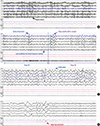Abstract
Sleep is a highly organized and complicated state that is fundamental to life. We have an absolute need to sleep during about one-third of our lives. There are two types of sleep, non-rapid eye movement (NREM) and rapid eye movement (REM) sleep. NREM sleep is divided into stages 1, 2, and 3 which is representing a degree of relative depth in sleep. Each sleep stage shows unique features including some variations in electroencephalographic waves, eye movements, and muscle tone. Although sleep pattern changes are associated with aging, how sleep physiology and sleep patterns change over an individual's life span is not well-defined. Circadian rhythms, which are the daily rhythms in physiology and behavior, regulate the sleep-wake cycle. Comprehensive understanding of normal sleep physiology should be very important to better understand not only the effects of sleep related diseases but also the impacts of pathological sleep on various diseases of other systemic organs. This review aims to enhance knowledge focused on normal sleep physiology and its regulation.
Figures and Tables
 | Fig. 1The hypnogram of a healthy adult represents a normal sleep architecture. There are 4 to 6 sleep cycles during the night. Slow wave sleep (stage N3) is longer early in the sleep period. Rapid eye movement sleep (stage R) increases in frequency and length later during the sleep period. Brief awakenings can be present normally during the sleep period. |
 | Fig. 2Typical polysomnographic findings during wake and sleep stages. A. Stage W: Alpha rhytms is the marker for wake stage. B. Stage N1 and N2 sleep: Slow eye movements, low amplitude and mixed frequency activity, vertex sharp waves indicates stage N1 sleep. K complex and sleep spindle are observed during stage N2 sleep. C. Stage N3 sleep: More than 20% of an epoch consists of slow wave activity during stage N3 sleep. D. Stage R sleep: Rapid eye movements and low chin electromyography (EMG) tone are characteristic features of stage R sleep. |
 | Fig. 3Two-process model of sleep regulation. Process S indicates the homeostatic built-up of sleep pressure and Process C represents the circadian rhythm. |
 | Fig. 4Sleep and age. WASO, wakefulness after sleep onset; REM, rapid eye movement. Ref. 19 with permission from The Korean Neurological Association. |
References
2. Sinton CM, McCarley RW. Neurophysiological mechanisms of sleep and wakefulness: a question of balance. Semin Neurol. 2004; 24:211–223.

3. Carskadon MA, Dement WC. Normal human sleep: An overview. In : Kryger MH, Roth T, Dement WC, editors. Principles and practice of sleep medicine. 5th ed. St. Louis: Elsevier Health Sciences;2011. p. 16–26.
4. Iber C, Ancoli-Israel S, Chesson A, Quan SF. The AASM manual for the scoring of sleep and associated events: rules, terminology and technical specifications. 1st ed. Westchester, IL: American Academy of Sleep Medicine;2007.
5. Markov D, Jaffe F, Doghramji K. Update on parasomnias: a review for psychiatric practice. Psychiatry (Edgmont). 2006; 3:69–76.
6. Roth T, Roehrs T. Sleep organization and regulation. Neurology. 2000; 54:S2–S7.
7. Kräuchi K, de Boer T. Body temperature, sleep, and hibernation. In : Kryger MH, Roth T, Dement WC, editors. Principles and practice of sleep medicine. 5th ed. St. Louis: Elsevier Health Sciences;2011. p. 323–334.
8. Achermann P, Borbély AA. Sleep homeostasis and models of sleep regulation. In : Kryger MH, Roth T, Dement WC, editors. Principles and practice of sleep medicine. 5th ed. St. Louis: Elsevier Health Sciences;2011. p. 431–444.
9. Pace-Schott EF, Hobson JA. The neurobiology of sleep: genetics, cellular physiology and subcortical networks. Nat Rev Neurosci. 2002; 3:591–605.

11. Young ME, Bray MS. Potential role for peripheral circadian clock dyssynchrony in the pathogenesis of cardiovascular dysfunction. Sleep Med. 2007; 8:656–667.

12. Dibner C, Schibler U, Albrecht U. The mammalian circadian timing system: organization and coordination of central and peripheral clocks. Annu Rev Physiol. 2010; 72:517–549.

13. Berson DM, Dunn FA, Takao M. Phototransduction by retinal ganglion cells that set the circadian clock. Science. 2002; 295:1070–1073.

14. Roffwarg HP, Muzio JN, Dement WC. Ontogenetic development of the human sleep-dream cycle. Science. 1966; 152:604–619.

15. Adair RH, Bauchner H. Sleep problems in childhood. Curr Probl Pediatr. 1993; 23:147–170. discussion 142.

16. Davis KF, Parker KP, Montgomery GL. Sleep in infants and young children: Part one: normal sleep. J Pediatr Health Care. 2004; 18:65–71.
17. Bliwise DL. Normal aging. In : Kryger MH, Roth T, Dement WC, editors. Principles and practice of sleep medicine. 5th ed. St. Louis: Elsevier Health Sciences;2011. p. 27–41.
18. Roth T. Characteristics and determinants of normal sleep. J Clin Psychiatry. 2004; 65:Suppl 16. 8–11.
19. The Korean Neurological Association. Textbook of Neurology. 2nd ed. Seoul: Bummoon Education;2012. p. 413.
20. Chokroverty S. Physiologic changes in sleep. In : Chokroverty S, editor. Sleep Disorders Medicine. Boston: Butterworth-Heinemann;1999. p. 95–126.
21. Desseilles M, Dang-Vu T, Schabus M, Sterpenich V, Maquet P, Schwartz S. Neuroimaging insights into the pathophysiology of sleep disorders. Sleep. 2008; 31:777–794.

22. Braun AR, Balkin TJ, Wesenten NJ, Carson RE, Varga M, Baldwin P, et al. Regional cerebral blood flow throughout the sleep-wake cycle. An H2(15)O PET study. Brain. 1997; 120(Pt 7):1173–1197.

23. España RA, Scammell TE. Sleep neurobiology for the clinician. Sleep. 2004; 27:811–820.
24. Saper CB, Scammell TE, Lu J. Hypothalamic regulation of sleep and circadian rhythms. Nature. 2005; 437:1257–1263.

25. Borbély AA, Achermann P. Sleep homeostasis and models of sleep regulation. J Biol Rhythms. 1999; 14:557–568.

26. Mignot E, Taheri S, Nishino S. Sleeping with the hypothalamus: emerging therapeutic targets for sleep disorders. Nat Neurosci. 2002; 5:Suppl. 1071–1075.

27. Saper CB, Cano G, Scammell TE. Homeostatic, circadian, and emotional regulation of sleep. J Comp Neurol. 2005; 493:92–98.

28. Siegel JM, Moore R, Thannickal T, Nienhuis R. A brief history of hypocretin/orexin and narcolepsy. Neuropsychopharmacology. 2001; 25:S14–S20.





 PDF
PDF ePub
ePub Citation
Citation Print
Print




 XML Download
XML Download